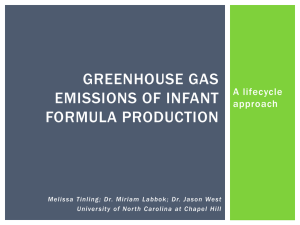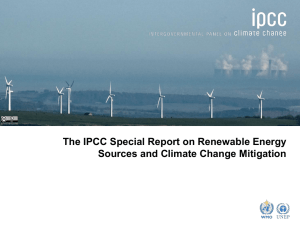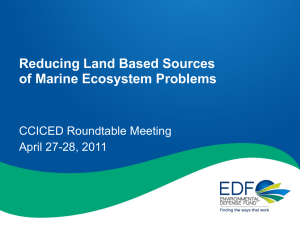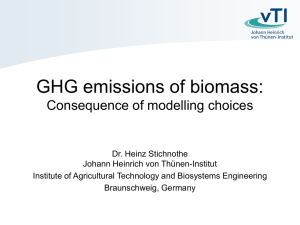Icreasing biofuels in transport: policy drivers
advertisement
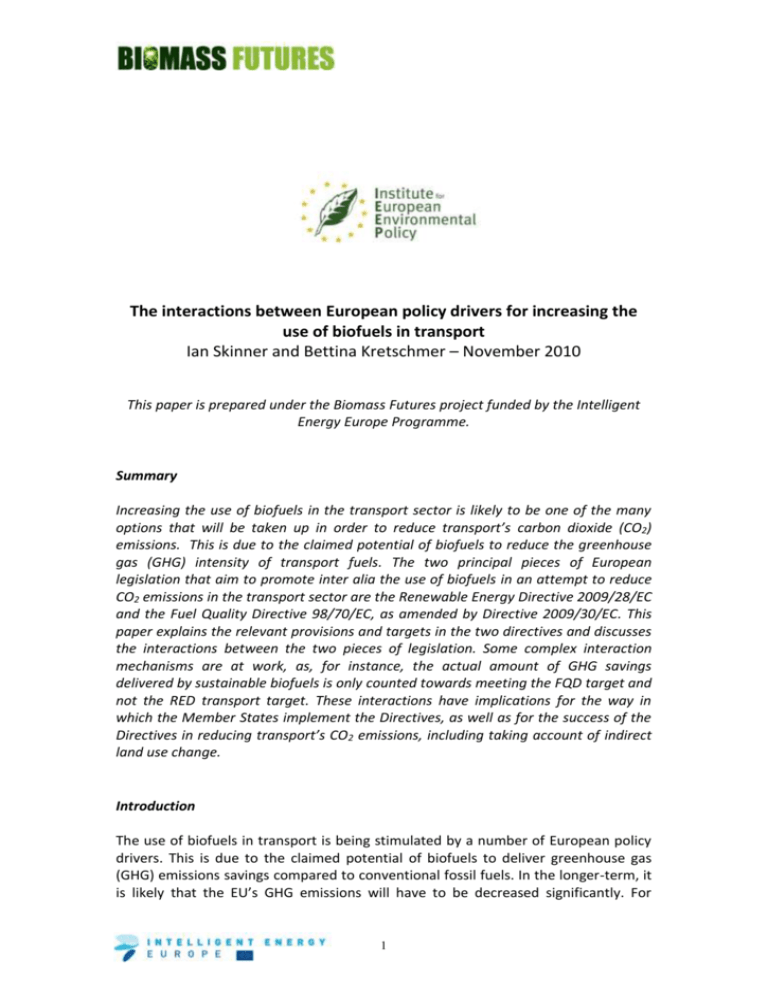
The interactions between European policy drivers for increasing the use of biofuels in transport Ian Skinner and Bettina Kretschmer – November 2010 This paper is prepared under the Biomass Futures project funded by the Intelligent Energy Europe Programme. Summary Increasing the use of biofuels in the transport sector is likely to be one of the many options that will be taken up in order to reduce transport’s carbon dioxide (CO2) emissions. This is due to the claimed potential of biofuels to reduce the greenhouse gas (GHG) intensity of transport fuels. The two principal pieces of European legislation that aim to promote inter alia the use of biofuels in an attempt to reduce CO2 emissions in the transport sector are the Renewable Energy Directive 2009/28/EC and the Fuel Quality Directive 98/70/EC, as amended by Directive 2009/30/EC. This paper explains the relevant provisions and targets in the two directives and discusses the interactions between the two pieces of legislation. Some complex interaction mechanisms are at work, as, for instance, the actual amount of GHG savings delivered by sustainable biofuels is only counted towards meeting the FQD target and not the RED transport target. These interactions have implications for the way in which the Member States implement the Directives, as well as for the success of the Directives in reducing transport’s CO2 emissions, including taking account of indirect land use change. Introduction The use of biofuels in transport is being stimulated by a number of European policy drivers. This is due to the claimed potential of biofuels to deliver greenhouse gas (GHG) emissions savings compared to conventional fossil fuels. In the longer-term, it is likely that the EU’s GHG emissions will have to be decreased significantly. For 1 example, in December 2009 EU leaders called for international action in line with the EU objective of reducing GHG emissions by between 80% and 95% by 2050 compared to 1990 levels1. In spite of the fact that an international agreement has yet to be agreed to this effect, the EU’s Europe 2020 strategy2, which was published in March 2010, committed the Commission to present proposals to “modernise and decarbonise” the EU transport sector, as these would contribute to increased competitiveness. Reducing the carbon intensity of the energy used by transport is one means of reducing transport’s GHG emissions, which are largely carbon dioxide (CO 2). In the medium- to long-term, it is likely that the energy mix used in the transport sector will change significantly, so biofuels will not be the only way to decarbonise transport’s solution. They are, however, at present the only commercially viable decarbonisation option. Their competitiveness compared to other low(er)-carbon energy sources for transport such as gas, electricity or hydrogen also stems from the fact that no new distribution networks are needed and that conventional petrol or diesel engines can be fuelled with biofuels at least up to a certain blend rate. This paper explores the two main pieces of European legislation that stimulate the increased use of biofuels in the EU transport sector, i.e.: o Renewable Energy Directive 2009/28/EC (RED)3. o Fuel Quality Directive 98/70/EC, as amended by Directive 2009/30/EC (FQD)4. While other legislation may have an indirect impact on the amount of biofuels needed by the EU transport sector, the RED and the FQD will directly affect the amount of biofuels used. For example, the energy services Directive5 sets Member States an indicative energy savings target of 9% by 2015, which can be met by applying a range of energy efficiency measures, including measures in the transport sector. Consequently, if a Member State chose to deliver energy savings in the transport sector, then less energy (in absolute terms) would be needed from renewable sources under the RED6. Other European policies that aim to reduce 1 Presidency Conclusions, Brussels European Council, 29/30 October 2009; see http://register.consilium.europa.eu/pdf/en/09/st15/st15265.en09.pdf 2 COM(2010) 2020 Communication from the Commission, Europe 2020: A strategy for smart, sustainable and inclusive growth 3.3.2010 3 Directive 2009/28/EC on the promotion of the use of energy from renewable sources; see http://eurlex.europa.eu/LexUriServ/LexUriServ.do?uri=OJ:L:2009:140:0016:0062:EN:PDF. 4 Directive 98/70/EC relating to the quality of petrol and diesel fuels; and Directive 2009/30/EC amending Directive 98/70/EC as regards the specification of petrol, diesel and gas-oil and introducing a mechanism to monitor and reduce greenhouse gas emissions; see http://eurlex.europa.eu/LexUriServ/LexUriServ.do?uri=OJ:L:2009:140:0088:0113:EN:PDF 5 Directive 2006/32 on energy end-use efficiency and energy services 2 transport’s GHG emissions, eg the Regulation on passenger car CO27, do not impact directly on the use of biofuels. The next two sections explains the relevant provisions and targets of, for the RED and then the FQD. The next section explores the various interactions between the two directives before the paper finishes with some concluding remarks. The Renewable Energy Directive 2009/28/EC The RED sets a target that requires each Member State to increase the proportion of energy from renewable sources in its final consumption of energy by 2020. In addition, Article 3(4) of the RED sets a minimum target of 10% for the proportion of final energy consumption in transport that should be from renewable sources by 2020. Whereas the overall RED target is differentiated across Member States according to past renewable energy shares and GDP per capita, the RED transport target is the same for all Member States. For the purpose of calculating the total amount of renewable energy consumed by transport, “all types of energy from renewable sources consumed in all forms of transport” should be taken into account. However, in the calculation of the total amount of energy consumed by transport, only petrol, diesel and biofuels8 used in rail and road transport, as well as electricity, are relevant. The RED also attempts to encourage the development of different feedstocks for biofuels. Article 21(2) states that biofuels produced from “wastes, residues, non-food cellulosic material, and ligno-cellulosic material” should be counted double the contribution made by other biofuels9. In an attempt to ensure that both the RED and FQD stimulate the uptake of only those biofuels that could be considered to be sustainable, Article 17 of the RED (and Article 7(b) of the FQD) establishes sustainability criteria for biofuels. These state that only those biofuels meeting the sustainability criteria listed10 should be taken 6 According to a synthesis of the National Energy Efficiency Action Plans submitted in 2007 by Member States under this Directive (SEC 2009 889), energy savings in the transport sector were the most significant source of anticipated energy savings in some Member States (eg Bulgaria, Greece, Portugal, Spain and Romania), while other Member States (e.g. Denmark, Estonia and Lithuania) included no energy savings from transport. 7 Regulation 443/2009 setting emission performance standards for new passenger cars 8 In the Directive ‘biofuels’ are defined as ‘liquid or gaseous fuel for transport produced from biomass’. Hence, biogas is included in this definition. The Directive uses the term ‘bioliquids’ for liquids that have been produced from biomass, but are used for energy purposes in sectors other than transport. 9 A similar incentive is included to encourage the use of electric road vehicles, as the actual energy content of the electricity from renewable sources used by these vehicles should be multiplied by 2.5. 10 In paragraphs 2 to 6 of Article 17 3 into account in relation to measuring compliance with the targets in the Directives11. The first of these five criteria relates to the GHG reduction requirements of the biofuels12. This states that to be eligible to be counted as renewable for the purposes of the Directives, the GHG savings from the use of the biofuels must be at least 35%13. From 1 January 2017, this proportion increases to 50%, while new installations that started production in 2017 or later would have to deliver GHG savings of 60% by 1 January 2018. Article 19(1) (and Annex V) set out how the GHG savings should be calculated and make it clear that the lifecycle GHG emissions of biofuels are to be taken into account in this calculation, including emissions arising from newly converted cropland. However, it is important to note that there are uncertainties in calculating direct emissions and problems in calculating indirect emissions (see below). Consequently, the GHG saving threshold (ie having a 35% GHG reduction requirement, rather than simply a requirement for a reduction) is applied in order to provide a degree of assurance that the increased use of biofuels will lead to reductions in GHG emissions compared to fossil fuel. While both renewable electricity and biofuels, and possibly renewable hydrogen, could be used to meet the RED transport target, an analysis of the Action Plans submitted under the RED by Atanasiu (2010) has shown that Member States anticipate that biofuels will deliver 89.3% of this target14. The Fuel Quality Directive 98/70/EC, as amended by Directive 2009/30/EC The FQD originally only set quality standards for petrol and diesel used in the transport sector. It has subsequently been extended to cover petrol and diesel fuels used in non road mobile machinery, which includes railway applications, as well as fuel used by inland waterway vessels and recreational craft when these are not being used at sea. The most recent amendment (by Directive 2009/30/EC) added a target for the reduction of lifecycle GHG emissions of these fuels as part of the integrated approach on CO2 and cars. This target is set in Article 7a(2) and mandates Member States to ensure that energy suppliers reduce lifecycle GHG emissions (per unit of 11 This is stated more explicitly in Article 5(1), which states that biofuels that do not fulfil the sustainability criteria should not be taken into account in the calculation of the final consumption of energy from renewable sources. 12 Other criteria place restrictions on the type of land that can be used for growing biomass for biofuels, i.e. this should generally not have a high biodiversity value, should not generally have a high carbon stock and should not generally be peatland, and the requirements with respect to the use of agricultural raw materials. 13 For installations in operation on 23 January 2008, this target is to be met by 1 April 2013. 14 Atanasiu, B. (2010). Flash Forward on Bioenergy in 2020: Facts and uncertainties on bioenergy role in the National Renewable Energy Action Plans. To be released on www.ieep.eu and www.biomassfutures.eu. This analysis was based on the Action Plans of the 23 Member States that had submitted their plans at the time. The figure quoted does not include data for Poland, Hungary, Estonia and Belgium. 4 energy from fuel and energy supplied) by at least 6% by the end of 2020 (compared to the baseline in 2010). In order to potentially increase this figure to 10%, the Directive also includes two additional targets (subject to a review by the Commission): An indicative target of 2% to be achieved by either: o the supply of energy for transport for use in any type of road vehicle or non road mobile machinery; and/or o the use technology (including carbon capture and storage) that can reduce lifecycle GHG emissions per unit of energy from energy or fuel supplied. An indicative target of 2% to be achieved through the use of credits purchased through the Kyoto Protocol’s Clean Development Mechanism15. Recital 9 of the Directive indicates the potential source of savings that might be delivered in the supply of energy, as it notes that GHG savings could be delivered from “reductions in flaring and venting at production sites”, in addition to biofuels and other alternative fuels. Other options would be to reduce emissions from refining generally and to use less GHG intensive fuels. Rather than define biofuels itself, Article 2(9) of the FQD refers directly to the definition of biofuels used in the RED. As noted above, Article 7b of the FQD (along with Article 17 of the RED) sets out the sustainability criteria that biofuels have to meet in order to be able to be taken into account in the GHG savings target. Article 7d(1) and Annex IV use corresponding language to that of the RED to set out the way in which the lifecycle GHG emissions of biofuels are to be calculated. However, the method for calculating lifecycle GHG emissions from fuels and energy other than biofuels was not set out in the Directive and was subsequently consulted upon by the Commission16. Interactions between the RED and amended FQD As noted in the previous section, the RED and amended FQD have common definitions of biofuels, the same sustainability criteria for biofuels and the same method for calculating the lifecycle GHG emissions of biofuels. Additionally, in both Directives, it is stated that the various implementing measures “shall take full account of the purposes” of the other Directive, while Article 7e(2) of the FQD states that the various reports that are to be submitted regarding the sustainability of biofuels shall be submitted for the purposes of both the FQD and the RED. 15 This is to be done in way that is consistent with the conditions set out in the emissions trading Directive 2003/87/EC. 16 The public consultation closed on 25 September 2009. http://ec.europa.eu/environment/air/transport/fuel.htm for the consultation documents. 5 See However, there are differences in the approaches taken in each, which have potential implications for the way in which they might operate together. Some of these are explored below. Interaction of the targets The way in which the targets are set in the two Directives requires the calculation of GHG savings in order to determine whether the biofuels are sufficiently sustainable to count towards meeting the respective targets. Under the RED, if the biofuels are considered to be sustainable, the calculated GHG savings are not used in their own right, rather the associated energy content (measured in MJ) is included in the calculation of the renewable energy used in transport. On the other hand, in the FQD, the calculated GHG emissions (expressed as gCO2eq/MJ) are used to determine whether the savings can be counted towards meeting the respective target AND as a contribution to meeting this target. Consequently, for the purposes of the RED, it does not matter whether the GHG savings of the biofuels are 35% (or 50% from 2017) or 85%, the same figure (the energy content of the biofuels) will be used in the calculation of the proportion of renewable energy used in transport. However, for the purposes of the FQD, the second of these biofuels would be much more beneficial, as it delivers more GHG savings and therefore contributes more to delivering the respective FQD target. An implication of the way in which the sustainability criteria are defined is that biofuels that are reported to deliver GHG savings of less than 35% (or less than 50% from 2017) cannot be counted towards meeting the targets in either the RED or the FQD, even though they may still be considered to deliver GHG savings. Hence, if a Member State were to produce 10% of its transport energy from biofuels that produce estimated GHG savings of only 25%, these could not be counted towards meeting the targets in either Directive. In such a case, the Member State would have reduced its transport GHG emissions by an estimated 2.5%17, but this could not be counted towards meeting the FQD target, as these biofuels would not satisfy the sustainability criteria. Article 21(2) of the RED, which aims to stimulate the uptake of different feedstocks by doubling their energy content in the calculation of the target, also has implications for the way in which the different targets might be met. As a result of this provision, a Member State could theoretically meet its RED transport target by producing just over 5% of its energy18 from sustainable biofuels made from these feedstocks. However, even if these biofuels delivered GHG savings of 100% compared to fossil fuels, the Member State would not meet its mandatory 6% GHG 17 Assuming that there were no biofuels in use in 2010. 18 In fact 5.3%, as the doubling applies to both the numerator and the denominator of the calculation. 6 reduction target under the FQD19. Analysis of the Member State reports submitted under RED by Atanasiu (2010) suggests that, while Article 21 biofuels are anticipated to deliver less than 10% of this target, some Member States are reporting that all of their biofuels usage by 2020 would be Article 21 biofuels. In such cases it will be important not to assume that meeting the RED target would also imply that the minimum FQD had been met. On the other hand, a Member State could meet the FQD target, but not the RED transport target. For example, if suppliers in a Member State were to use biofuels with a GHG intensity that is 25% that of fossil fuels to satisfy the FQD target, they would only need to use 8% biofuels as part of their fuel mix, which would not be sufficient for the Member State to meet the RED target. Implications of differences in modal coverage The scope of the targets in terms of modal coverage is slightly different. Biofuels that meet the sustainability criteria, and which are used in the maritime and aviation sectors, are included in the calculation of transport energy from renewable sources in the RED, but these cannot be taken into account to meet the GHG savings target of the FQD. On the other hand, GHG savings from fuel used in some non-transport applications, eg non road mobile machinery, agricultural and forestry tractors, can contribute to meeting the GHG savings target of the FQD, but do not count towards meeting the transport target of the RED20. The modal coverage within the RED is also not completely consistent. Any sustainable biofuels used in the aviation and maritime sectors would contribute to the delivery of the transport target in the RED. However, the energy from other sources used by these modes is not used in the calculation of the RED transport target in spite of the anticipated large increases in energy use from these modes21. Hence, these increasing trends, which if included in the calculation would have made 19 This assumes that no GHG savings were delivered in other ways. In this case, if 5.3% of transport energy was produced from sustainable Article 21 biofuels delivering 100% savings, the resulting GHG saving would only be 5.3%. 20 The RED defines liquid produced from biomass that is used in sectors other than transport as “bioliquids”. The same sustainability criteria apply to bioliquids and biofuels in the RED, so any bioliquids used in non-transport applications that contribute to the FQD GHG savings target would need to meet the same sustainability criteria as biofuels used by transport. While not counting towards the RED transport target, bioliquids used in non-road mobile machinery would count towards meeting the overall RED target. 21 For example, see Skinner I, van Essen H, Smokers R and Hill N (2010). Towards the decarbonisation of EU’s transport sector by 2050 Final report produced under the contract ENV.C.3/SER/2008/0053 between European Commission Directorate-General Environment and AEA Technology plc; see www.eutransportghg2050.eu 7 the attainment of the target more difficult22, are not taken into account in the calculation23. Implications of potential changes to GHG intensity figures Part C of Annex V of the RED and Annex IV of the FQD set out how GHG emissions, including savings, from biofuels should be calculated. Savings are to be calculated by subtracting the GHG emissions of the biofuels from that of fossil fuels and then dividing by the fossil fuel emissions, to give a percentage that has to be larger than 35% (or 50% from 2017) for the biofuel to be considered to be sustainable. The GHG emissions from fossil fuels (referred to as the ‘fossil fuel comparator’) are to be the most recent actual average emissions from petrol and diesel consumed in the EU, as reported under the FQD, or a default value of 83.8gCO2eq/MJ24 if no such data are available. Consequently, using this fossil fuel comparator, biofuels would have to deliver emissions of less than 54.47gCO2eq/MJ to be considered sustainable and thus be eligible to be counted towards the transport target in the RED and the GHG savings target of the FQD. However, as soon as the fossil fuel comparator is reported upon under the FQD 25, there is the potential for its value to change from year to year, e.g. if the indicative targets in the FQD begin to deliver GHG savings. On the other hand, the change in the actual average emissions is likely to be rather small and might not merit updating the comparator. If the lifecycle GHG emissions of fossil fuels fall, then the lifecycle emissions of biofuels would also have to fall in order to continue to be considered to be sustainable. Consequently, a biofuel that was considered sustainable in one year, and therefore could be included in the calculation of progress towards the target, might not be considered to be sustainable in the following year. This approach ensures that there is an incentive for continuous reductions in the lifecycle GHG emissions from biofuels. In the longer-term, ie from 2017 onwards, the stricter emissions savings criteria that a biofuel would have to meet to be considered to be sustainable would deliver a similar incentive. On the other hand, if lifecycle GHG emissions from fossil fuels increase, then biofuels that were previously not considered to be sustainable could become sufficiently 22 As they would increase the denominator of the calculation significantly, which in turn would mean that the transport sector would need to consume more sustainable renewable energy in order to meet the 10% target. 23 The description of how to calculate the amount of energy consumed in aviation in Article 5(6) does not therefore seem to apply to the transport-specific target, only to the overall RED target. 24 Annex V. C.19 of the RED (repeated in Annex IV.C.19 of the FQD). 25 As Member States did not have to transpose Directive 2009/30/EC until the end of 2010, the GHG emissions elements of the amended Directive will not be applied until 2011 and therefore not reported upon to the Commission until mid-2012. Given that it will take time to analyse the respective Member State reports, it is unlikely that a GHG intensity value based on these reports will be in place before the end of 2012 at the earliest. 8 sustainable to be counted towards meeting the RED and FQD targets. Such an increase in lifecycle fossil fuel GHG emissions might happen if, for example, the use of “unconventional” fossil fuel feedstocks, which are more GHG intensive to produce, e.g. oil sands or oil shale, increases. However, whether such GHG emissions will be considered by the FQD will depend on the final method for calculating lifecycle GHG emissions from fuels and energy other than biofuels, which has not yet been finalised (although the Commission has consulted on this; see above). The calculation of lifecycle GHG emissions for fossil fuels could include a single factor for fossil fuels no matter how they are produced, ie the same GHG factor would apply to fuel produced from conventional crude oil and fuel produced from oil sands, or different factors that take account of the different lifecycle GHG emissions of different fossil fuel feedstocks. The agreed method of calculation is likely to be published in the first quarter of 2011. If a single factor is chosen for all fossil fuels, irrespective of their production method, the indicative targets under the FQD might deliver reported GHG emissions savings from fossil fuels (as measured under the FQD), and this decline would act as a driver for improved GHG savings from biofuels. However, in such a case, real-world lifecycle GHG emissions from fossil fuels might increase if more unconventional feedstocks, which are more GHG intensive, are used to produce petrol and diesel. On the other hand, if the differences in lifecycle GHG emissions of different fossil fuel feedstocks are taken into account, there will be more of an incentive on fuel suppliers to increase their use of lower GHG intensity fuels, which increases the likelihood of real lifecycle GHG emissions reductions from fossil fuels. Similarly, reviews of the various GHG emissions for biofuels, which could be updated to reflect technical and scientific progress, could have a similar impact on the sustainability of a particular biofuel, depending on whether the values increase or decrease. Potential implications for policy of indirect land use change According to Article 19(6) of the RED and Article 7a(6) of the FQD, the European Commission has to report on indirect land use change (ILUC) induced by the promotion of biofuels. The report is supposed to be delivered by the end of December 2010 and will assess whether action on ILUC should be taken; in the latter case, a legislative proposal would accompany the report. Among the policy options under discussion is the inclusion of an ILUC factor or adder in the lifecycle emissions calculations of biofuels in order to account of the GHG emissions arising from the fact that biofuel feedstock cultivation may displace other agricultural land uses, which in turn would lead to the conversion of new land for agricultural production26. As explained above, it does not make a difference under the RED whether a biofuel just meets or overshoots the GHG threshold of 35%. The difference in GHG emissions 26 For a discussion of indirect land use change, see Kretschmer (2010) The Land-Use Implications of EU Bioenergy Policy – Going beyond ILUC. To be released on www.ieep.eu. 9 is, however, central to the operation of the FQD. Consequently, the inclusion of an ILUC factor would increase the reported lifecycle GHG emissions for those biofuels causing ILUC, and so mean that these would contribute less to meeting the GHG intensity reduction target of the FQD. In order to meet the FQD emission reduction target, mitigation efforts would therefore have to be enhanced, if an ILUC factor was in place compared to a situation without such a factor. This could either imply the enhanced use of other mitigation options, such as reductions in flaring and venting, but also a change in the type of biofuels used, an improvement in the direct GHG emissions performance of the biofuel used or even an increase in biofuel use. In such a case, the demand for an additional unit of biofuel would be driven by the FQD instead of the RED. If an ILUC factor correctly reflected GHG emissions from land use change that occur as a consequence of biofuels displacing other agricultural land uses, it would be perfectly valid to add these emissions to biofuel emissions when these are compared to fossil fuels with the discussed consequences under the FQD. It will be necessary to take into account the level of uncertainty associated with the ILUC estimates when designing policy aimed at tackling ILUC because of the effects that an ILUC factor would have for mitigation efforts under the FQD. Concluding remarks The RED and amended FQD both have the potential to contribute towards GHG reductions from transport by increasing the proportion of renewable, sustainable and lower GHG intensity fuels and energy used by transport. However, the mechanisms with which the two Directives operate are different in terms of coverage, as well as how and to whom the incentive for action is given. Additionally, the detail of both Directives, some of which has yet to be finalised, will be crucial both to the incentives given and to the realisation of real GHG emissions reductions. Both Directives also include numerous review mechanisms, not least of the FQD targets, and potential updates to technical and scientific progress, which will also influence whether the targets remain in the same form. Consequently, the way in which the Directives work together in order to deliver their respective targets is likely to be a developing process and one that should, as long as the reviews and updating of the Directives do not weaken their respective targets, contribute towards decarbonising transport. 10

